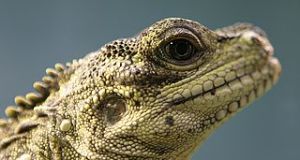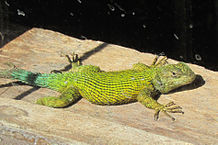The green anole has long been a pet trade staple, but these active, attractively-colored little lizards have quite an interesting natural history as well. Today we’ll take a look at how they live and cope with people, and point out some of their special traits. Next week I’ll cover their care in captivity. Classification
Family Iguanidae, Subfamily Polytrotinae.
Note: some authorities have reclassified certain Anolis species as Norops.
 At least 370 anole species range throughout southern North America, Central America, South America and the Caribbean. All are fairly small, slender, egg-laying lizards. Males possess a large, colorful throat fan (dewlap) that is used in territorial displays and other forms of communication; depending upon the species, the female’s dewlap is smaller or vestigial.
At least 370 anole species range throughout southern North America, Central America, South America and the Caribbean. All are fairly small, slender, egg-laying lizards. Males possess a large, colorful throat fan (dewlap) that is used in territorial displays and other forms of communication; depending upon the species, the female’s dewlap is smaller or vestigial.
The foot pads of most are equipped with lamellae (please see below) to assist in climbing. Nearly all are arboreal, with the tails of the “bush anoles” (Genus Polychrus) being prehensile. Several species, however (i.e. Genus Pristidactylus), are largely terrestrial.
Anoles feed mainly upon insects, spiders and other invertebrates. Several species have been observed to lap nectar and sap, and the Puerto Rican anole (A. cristatellus wileyae) sometimes consumes fruit.
The green anole is the only species native to the USA, although a number of others have been introduced here (please see below). The green anole population in southwestern Florida has recently been designated as a distinct subspecies, the pale-throated green anole, A. carolinensis seminolus.
Physical Description
The green anole is slenderly built, possessed of a long tail, and reaches 6 -7.5 inches in length. The color of each individual varies from light and dark brown to pale and bright green (please see below).
Males are larger and stockier than females and have a thicker tail base and a wider, more colorful dewlap (throat fan). The dewlap of the male is pink to pale red in color (white or cream-colored in A. c. seminolus), and is vestigial or absent in females.
Anoles clad in various shades of blue are sometimes available in the pet trade. Arising from a genetic mutation, they are quite striking.
Range
Green anoles are found from southern North Carolina west to eastern Texas and southeastern Oklahoma and south to the Florida Keys. They also live in the Bahamas, Grand Cayman Islands, Anguilla and Cuba. There are disjunct populations in Mexico.
Green anoles have been introduced to Belize, southern Japan and Hawaii, and have established breeding populations in those areas.
Habitat
Woodland edges, pine-palmetto scrub, cypress swamps, open forests, overgrown fields, farms, parks, backyards and gardens; highly arboreal.
Status in the Wild
Green anoles adapt well to some human disturbance and may even be drawn to gardens by high insect populations and the humidity generated by frequent plant-watering. They are, however, declining across parts of their range due to over-collection and to the effects of introduced Anolis species that occupy the same habitats and compete with (the brown anole) or prey upon (the knight anole) them.
Diet
Caterpillars, tree crickets, grasshoppers, flies, beetles, moths, ants, roaches, spiders and other invertebrates; they occasionally lap over-ripe fruit, nectar and sap.
Reproduction
The breeding season extends from April to September, although it is shorter in the northern part of the range. Males are highly territorial and battle interlopers. The male’s courtship display consists of vigorous head-bobbing with continued extensions of the dewlap. The dewlap reflects ultraviolet light and is perceived by the female as brilliantly colored.
Males chase females about and grasp them behind the neck during copulation. The first eggs, 1-2 in number, are laid 2-4 weeks after mating occurs. They may be buried in soil or secreted below leaf litter or even left the surface, along a log or other structure. Eggs are sometimes deposited in substrate that has accumulated among air plants or in tree knot-holes above-ground. Additional clutches of 1-2 eggs are laid throughout the breeding season, to a total of 8-10 eggs per female. The eggs hatch in 30-45 days.
 That Reptile Blog – Reptile, Amphibian and Exotic Pet Care and Information
That Reptile Blog – Reptile, Amphibian and Exotic Pet Care and Information




I am looking to move to an area not to far from east TN. but can not seem to find areas where wild herps like anoles, house geckos, and other more tropical loving fauna and flora will be able to be had in my yard, without having to move all the way to FL., TX., or CA. Any help on what areas exactly I would be looking in?
Hello Stephen, Frank Indiviglio here. Thanks for your interest in our blog.
I apologize for being so long in responding. The delay was caused by a technical difficulty which has now been resolved.
Unfortunately, winters in eastern TN are a bit too cold for typically tropical animals. The native green anole just makes it into the southeastern part of the state, but the introduced species are all limited to southern Florida.
As far as another location, technically, the only semi-tropical region in the USA is southern Florida, although southern California and Texas, are, as you mention, fairly safe. Even in northern Florida, cold snaps kill off native lizards, and green anoles from south Florida cannot tolerate even a typical winter in the northern part of the state.
Living in eastern TN or adjoining areas of Georgia or the Carolinas will allow you to house tropical herps outdoors for a major portion of the year (far longer than here in NY, where it is about 50F as I write!), but you will need winter accommodations. I once assured a herpetologist friend from Venezuela, who was relocating to TN, that it was quite warm there year-round…he arrived, clad in shorts and sandals, to 2 feet of snow!
Please let me know if you have any specific animals in mind, and I’ll provide more detailed information…some contacts of mine have kept herps outdoors in northern Florida for many years, and their experience might be useful in providing general guidelines for other areas.
Good luck, please keep me posted.
Best regards, Frank Indiviglio.